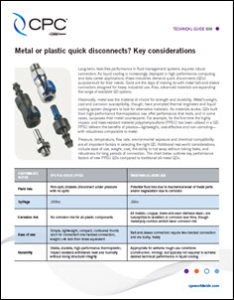
Long-term, leak-free performance in fluid management systems requires robust connectors. As liquid cooling is increasingly deployed in high performance computing and data center applications, these industries demand quick disconnects (QDs) purpose-built for their needs. Gone are the days of making do with metal ball-and-sleeve connectors designed for heavy industrial use. Also, advanced materials are expanding the range of available QD options.
Historically, metal was the material of choice for strength and durability. Metal’s weight, cost and corrosion susceptibility, though, have prompted thermal engineers and liquid cooling system designers to look for alternative materials. As materials evolve, QDs built from high-performance thermoplastics now offer performance that rivals, and in some cases, surpasses their metal counterparts. For example, for the first time the highly impact- and heat-resistant material polyphenylsulfone (PPSU) has been utilized in a QD. PPSU delivers the benefits of plastics—lightweight, cost-effective and non-corroding— with robustness comparable to metal.
Pressure, temperature, flow rate, environmental exposure and chemical compatibility are all important factors in selecting the right QD. Additional real-world considerations include ease of use, weight, cost, the ability to hot swap without risking leaks, and robustness for long periods of connection.
A new guide from CPC outlines key performance factors of new PPSU QDs compared to traditional all-metal QDs for liquid cooling.
Error: Contact form not found.
All information that you supply is protected by our privacy policy. By submitting your information you agree to our Terms of Use.
* All fields required.




